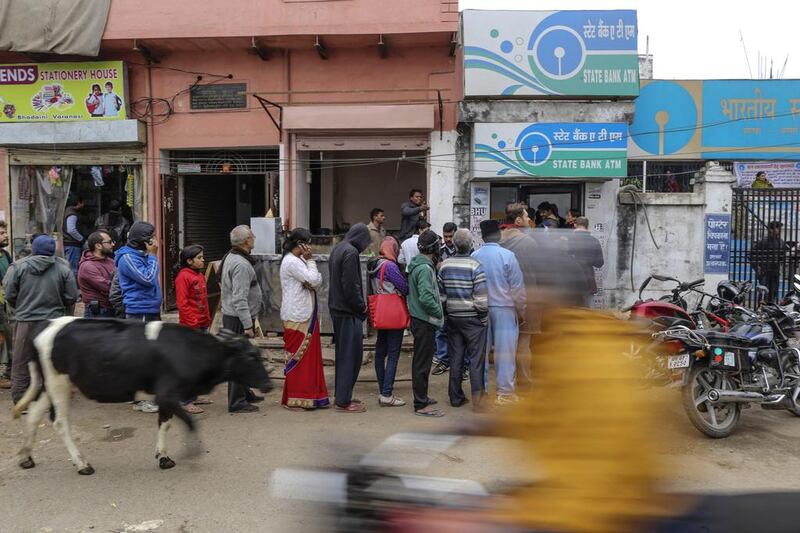Nine months after prime minister Narendra Modi announced a demonetisation drive, recalling all high-denomination currency notes, the government is yet to reveal how much money has been returned to it.
The objective of the demonetisation exercise, Mr Modi said in November last year, was to root out tax offenders — people who had undeclared stashes of currency, commonly called “black money”. But the reluctance to announce the value of received notes is prompting speculation that the mission to unearth black money has collapsed.
A failure on this front will prove a setback to Mr Modi’s government, given the hardships imposed on citizens by demonetisation and its harmful impact upon the economy.
When demonetisation was announced, roughly 15.44 trillion rupees (Dh890.6 billion) in 500 and 1,000 rupee notes were in circulation. The value of these notes represented 86 per cent of the value of all currency in circulation — a fact that left India suddenly dry of cash when Mr Modi declared the notes invalid at the start of the demonetisation drive.
Queues formed at ATMs, which promptly ran out of money. Day labourers, who are ordinarily paid in cash, suddenly found their wages withheld as banknotes became a precious commodity. Between January and March, economic growth slumped to 6.1 per cent — lower than both the target of 7.1 per cent and the 7.6 per cent growth seen during the same period last year.
People were urged to deposit their old notes into their bank accounts by the end of 2016. These notes were then absorbed by the Reserve Bank of India (RBI), the country's central bank, which would tally them.
The counting of these notes is still under way, the government insists. On July 13, Urjit Patel, the governor of the RBI told a parliamentary committee that all of the central bank’s 59 counting machines had been put into service. Seven more had been hired, Mr Patel said, and the RBI planned to buy more still.
Last week, Arun Jaitley, India’s finance minister, told parliament that the notes received “are being reconciled to obviate reporting errors and processed for verifying numerical accuracy and authenticity through machines”.
The question of how effective demonetisation would be against tax evasion and black money was hotly debated even in November.
"By making an unexpected announcement that high-value currency would not be valid, the government thought that [cash] hoarders would be caught off guard," John Raja, the founder of How India Lives, a firm that analyses public data, told The National.
Banks were instructed to register the details of people who came in to deposit cash, and to ask those who deposited particularly large sums to declare the sources of this income.
“The belief was that black money hoarders will find it difficult to exchange their old currencies with new ones,” Mr Raja said.
But the premise of this exercise was faulty, said C Rammanohar Reddy, an economist.
“Black money held in the form of cash is a very small proportion of total illegal wealth,” he said. “Those who do hold stocks of cash are powerful enough to launder it and recycle it in different ways into the banking system.”
The RBI’s claim that counting the volume of demonetised notes is still ongoing is not a credible one, Mr Raja said.
“The RBI was providing weekly updates on amounts of cash returned until the second week of December," he said. "How was it able to provide that?"
Even as early as January — three months after demonetisation kicked in — a Bloomberg report revealed that 97 per cent of all invalided notes had already been returned to the RBI.
That report was based on anonymous sourcing from people within the government who had knowledge of the process. At the time, the RBI denied that this figure was correct.
Mr Reddy also dismissed the notion that counting the returned notes would take more than nine months, given the number of machines and officials at the RBI’s disposal, and said he saw two other possible reasons for the delay.
“One is that the money that has been deposited in the banks is very close to the amount of high-denomination notes in circulation at the time,” he said. This would indicate that cash hoarders had somehow been able to “launder” their money — convert it into legitimately earned income that could go into the banking system.
Alternatively, it could mean that — contrary to the government’s claims — the volume of hoarded, undeclared cash in the hands of private citizens was far less than projected.
The other possible reason, Mr Reddy said, was that “the money in the form of high-value notes deposited is more than what was supposed to be in circulation”.
So either the RBI’s estimates of circulating currency were inaccurate or a failure in monitoring had failed to catch large sums of counterfeit banknotes that entered the banking system.
“Whatever the reason, it is an embarrassment to the government and the RBI,” Mr Reddy said. “So they are either checking and counter-checking, or they are just holding back” from revealing the results.





